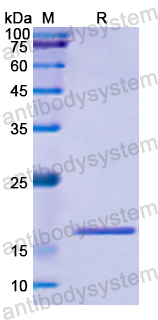Catalog No.
YHE38301
Expression system
E. coli
Species
Homo sapiens (Human)
Protein length
Ser803-Lys941
Predicted molecular weight
17.99 kDa
Nature
Recombinant
Endotoxin level
Please contact with the lab for this information.
Purity
>90% as determined by SDS-PAGE.
Accession
P42858
Applications
ELISA, Immunogen, SDS-PAGE, WB, Bioactivity testing in progress
Form
Lyophilized
Storage buffer
Lyophilized from a solution in PBS pH 7.4, 0.02% NLS, 1mM EDTA, 4% Trehalose, 1% Mannitol.
Reconstitution
Reconstitute in sterile water for a stock solution. A copy of datasheet will be provided with the products, please refer to it for details.
Shipping
In general, proteins are provided as lyophilized powder/frozen liquid. They are shipped out with dry ice/blue ice unless customers require otherwise.
Stability and Storage
Use a manual defrost freezer and avoid repeated freeze thaw cycles. Store at 2 to 8°C for frequent use. Store at -20 to -80°C for twelve months from the date of receipt.
Alternative Names
Huntingtin, HD protein, Huntington disease protein, HTT, HD, IT15
Restoring endogenous Dlg4/PSD95 expression by an artificial transcription factor ameliorates cognitive and motor learning deficits in the R6/2 mouse model of Huntington's disease., PMID:40506760
Direct Observation of Secondary Nucleation in Huntingtin Amyloid Formation by High-Speed Atomic Force Microscopy., PMID:40505012
Genetic modifiers of somatic expansion and clinical phenotypes in Huntington's disease highlight shared and tissue-specific effects., PMID:40490511
Genetic Inactivation of the Serotonin Transporter Dysregulates Expression of Neurotransmission Genes and Genome-Wide DNA Methylation Levels in the Medial Prefrontal Cortex of Male Rats During Postnatal Development., PMID:40485115
Concentration-dependent structural transition of huntingtin protein in Huntington's disease., PMID:40482382
Navigating the neuronal recycling bin: Another look at huntingtin in coordinating autophagy., PMID:40475846
Accurate Quantification of Mutant and Wild-Type polyQ Proteins Using Simple Western Capillary Immunoassays., PMID:40450087
Base editing of trinucleotide repeats that cause Huntington's disease and Friedreich's ataxia reduces somatic repeat expansions in patient cells and in mice., PMID:40419681
The influence of genetic factors on the severity of anxiety and depressive symptoms and the choice of coping strategies in reproductive tract cancer-a preliminary study., PMID:40416692
Microbiota dysbiosis impact on the immune system dysregulation in Huntington's disease (HD)., PMID:40414643
Evidence of an unprecedented cytoplasmic function of DDX11, the Warsaw breakage syndrome DNA helicase, in regulating autophagy., PMID:40413757
A potential role for NADPH oxidase (NOX1/2) in mutant huntingtin-induced anomalous neurite outgrowth., PMID:40412581
mTOR inhibition in Q175 Huntington's disease model mice facilitates neuronal autophagy and mutant huntingtin clearance., PMID:40392702
Berberine can be a Potential Therapeutic Agent in Treatment of Huntington's Disease: A Proposed Mechanistic Insight., PMID:40377895
Genetic variants of SLC6A4 and risk of coronary artery disease: insights from North Indian population., PMID:40369544
Dopamine Receptor D3 Induces Transient, mTORC1-Dependent Autophagy That Becomes Persistent, AMPK-Mediated, and Neuroprotective in Experimental Models of Huntington's Disease., PMID:40358175
Cerulenin Partially Corrects the Disrupted Developmental Transcriptomic Signature in Huntington's Disease Striatal Medium Spiny Neurons., PMID:40336225
Huntingtin inclusion bodies have distinct immunophenotypes and ubiquitination profiles in the Huntington's disease human cerebral cortex., PMID:40319093
Exploring the association between serotonin transporter promoter region methylation levels and depressive symptoms: a systematic review and multi-level meta-analysis., PMID:40319044
Targeted proteomic biomarker profiling using NULISA in a cohort enriched with risk for Alzheimer's disease and related dementias., PMID:40318118
Immobilizing the Endogenous 5-Hydroxytryptamine Transporter by Ligand-Directed and Proximity-Catalyzed Acyl Imidazole Chemistry for Affinity Chromatographic Analysis., PMID:40317770
Regulation of misfolded protein aggregation and degradation by SUMOylation in budding yeast., PMID:40305096
PRMT5 promotes full-length HTT expression by repressing multiple proximal intronic polyadenylation sites., PMID:40304179
[Finally, an understanding of Huntington's disease!]., PMID:40293154
Regulation of Genome Architecture in Huntington's Disease., PMID:40287840
Antioxidant and Anti-Inflammatory Defenses in Huntington's Disease: Roles of NRF2 and PGC-1α, and Therapeutic Strategies., PMID:40283130
Kinetin mediated mutant huntingtin phosphorylation restores multiple dysregulated pathways in a cell line model of Huntington's disease., PMID:40267238
Opposing roles for GSK3β and ERK1-dependent phosphorylation of huntingtin during neuronal dysfunction and cell death in Huntington's disease., PMID:40263294
Challenges and advances for huntingtin detection in cerebrospinal fluid: in support of relative quantification., PMID:40259428
Intersecting impact of CAG repeat and huntingtin knockout in stem cell-derived cortical neurons., PMID:40258535
Inhibitor-based modulation of huntingtin aggregation mechanisms mitigates fibril-induced cellular stress., PMID:40234398
Altered huntingtin-chromatin interactions predict transcriptional and epigenetic changes in Huntington's disease., PMID:40205980
Mutant huntingtin induces neuronal apoptosis via derepressing the non-canonical poly(A) polymerase PAPD5., PMID:40204699
Exploring Cordycepin as a Neuroprotective Agent in Huntington's Disease: In Vitro and In Vivo Insights., PMID:40202221
Multi-epitope immunocapture of huntingtin reveals striatum-selective molecular signatures., PMID:40169779
Molecular mechanisms and biomarkers in neurodegenerative disorders: a comprehensive review., PMID:40138119
Hyalinizing trabecular tumor of the thyroid: Interest of GLIS3 immunohistochemical study to detect PAX8::GLIS3 rearrangement., PMID:40122401
Structural-functional analyses of the huntingtin/HAP40 complex in Drosophila and humans., PMID:40091796
Transcriptomic analysis of intracellular RNA granules and small extracellular vesicles: Unmasking their overlap in a cell model of Huntington's disease., PMID:40090627
The breaking point where repeat expansion triggers neuronal collapse in Huntington's disease., PMID:40081335
CAG Repeat Instability and Region-Specific Gene Expression Changes in the SCA12 Brain., PMID:40075006
Intersecting impact of CAG repeat and Huntingtin knockout in stem cell-derived cortical neurons., PMID:40060574
Downregulation of Pten Improves Huntington's Disease Phenotype by Reducing Htt Aggregates and Cell Death., PMID:40042729
The therapeutic potential of (R)-carvedilol in Huntington's disease through enhancement of autophagy-lysosomal pathway via GSK-3β inhibition., PMID:40011132
Transcriptome Study in Sicilian Patients with Huntington's Disease., PMID:40002561
Advances in Huntington's Disease Biomarkers: A 10-Year Bibliometric Analysis and a Comprehensive Review., PMID:40001897
Multiple Copper Ions Bind to and Promote the Oligomerization of Huntingtin Protein with Nonpathological Repeat Expansions., PMID:39984289
Absence of hippocampal pathology persists in the Q175DN mouse model of Huntington's disease despite elevated HTT aggregation., PMID:39973391
Revisiting huntingtin activity and localization signals in the context of protein structure., PMID:39973382

